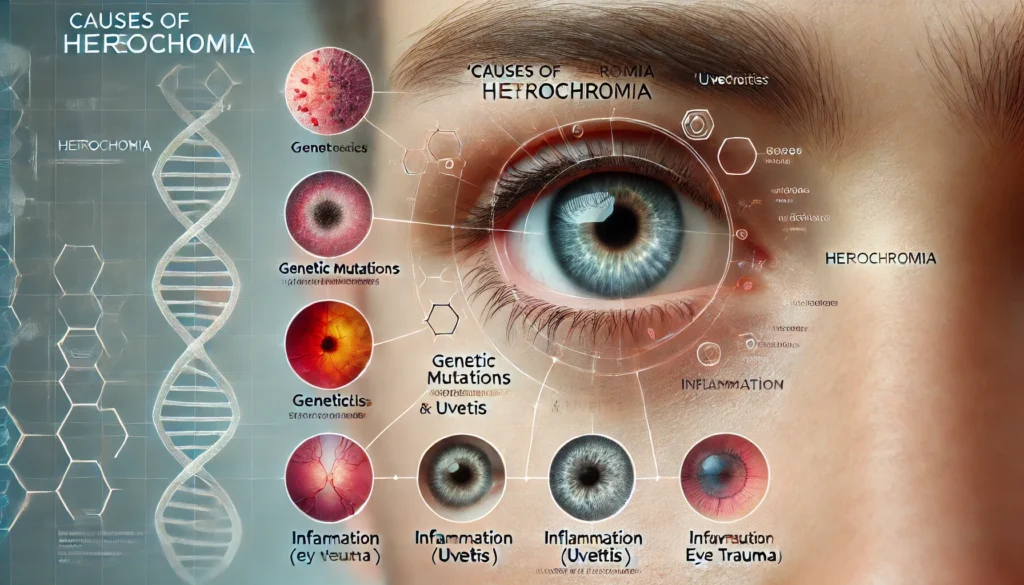Rare Changes in Eye Color: Exploring Heterochromia and Eye Color Shifts

- What Is Heterochromia?
- Types of Heterochromia
- Causes of Heterochromia
- Understanding Heterochromia: Types and Causes
- How to Identify Heterochromia
- Famous People Who Have Heterochromia
- Treatment Options for Heterochromia
- Comparisons with Other Eye Color Changes
- Conclusion: Embracing the Unique Beauty of Heterochromia
Eye color is one of the most unique and defining features of a person’s appearance. While most people have eyes that stay the same color throughout their lives, some individuals experience rare changes in eye color due to a condition known as heterochromia. Whether you're intrigued by different-colored eyes or want to understand more about this rare phenomenon, this article covers everything you need to know about heterochromia, its causes, types, and medical implications.
What Is Heterochromia?
Heterochromia is a rare condition where a person’s eyes are two different colors or a single eye has two distinct colors. It occurs when there is a variation in the distribution or amount of melanin in the iris, the part of the eye responsible for its color. Heterochromia can be congenital (present from birth) or acquired later in life due to certain medical conditions or trauma.

Types of Heterochromia
Heterochromia is classified into three main types, each presenting a different variation in eye color:

Complete Heterochromia
In complete heterochromia, each eye is a completely different color. For example, one eye may be blue, while the other is brown. This type is striking and most commonly recognized.
- Fact: The actress Kate Bosworth is known for having complete heterochromia, with one blue eye and one hazel eye.
Sectoral (Segmental) Heterochromia
Sectoral heterochromia occurs when part of one eye is a different color than the rest of the iris. The variation may not be as obvious as complete heterochromia but can create a multi-toned appearance in one or both eyes.
- Example: A person with sectoral heterochromia might have a large brown segment within a mostly green iris.
Central Heterochromia
In central heterochromia, the eye features two different colors, with one color concentrated around the pupil and another forming a ring on the outer part of the iris. This type can make the eyes appear to "shift" colors in different lighting.
- Fun Fact: People with central heterochromia often have irises that appear to change color based on lighting or their surroundings.
Genetic Factors in Eye Color Shift: What You Should Know
Causes of Heterochromia
Heterochromia can result from a variety of factors, ranging from genetics to medical conditions. It’s important to distinguish between congenital heterochromia, which a person is born with, and acquired heterochromia, which develops later in life.

Genetic Causes of Heterochromia
For many individuals, heterochromia is genetic and present from birth. Congenital heterochromia is often benign, meaning it doesn’t affect vision or health. It may occur due to spontaneous genetic mutations affecting melanin production.
- Prevalence: Heterochromia is rare, with no specific percentage for global occurrence. However, it is more common in animals like cats and dogs.
- Fact: While heterochromia is visually striking, it usually doesn’t indicate any medical issues when present at birth.
Acquired Heterochromia from Medical Conditions
When heterochromia develops later in life, it is referred to as acquired heterochromia. It can occur due to certain medical conditions, trauma, or even as a side effect of medications. Some of the most common causes include:
- Uveitis: Inflammation of the uvea, the middle layer of the eye, which can alter the color of the iris.
- Melanosis Oculi: A condition where abnormal melanin deposits in the eye can cause color changes.
- Ectropion Uveae: A rare condition in which part of the iris turns outward, leading to changes in eye color.
- Glaucoma Medications: Some treatments for glaucoma, such as prostaglandin analogs, can darken the iris over time.
- Example: Actress Mila Kunis developed heterochromia after a serious infection affected the pigment in one of her eyes.
The Role of OCA2 and HERC2 Genes in Eye Color Changes: How Genetics Shape Your Iris Color
Understanding Heterochromia: Types and Causes
Types of Heterochromia
Causes of Heterochromia
When to Consult a Doctor
How to Identify Heterochromia
Heterochromia can be easily identified by observing differences in eye color. However, it's important to know that not all cases of eye color variation are related to heterochromia.

When to Consult a Doctor
If you notice a sudden change in eye color, particularly in one eye, it’s important to consult with an ophthalmologist. While congenital heterochromia is typically harmless, acquired heterochromia can signal underlying health issues such as glaucoma, uveitis, or Horner's syndrome.
- Pro Tip: Keep track of any additional symptoms such as eye pain, vision changes, or inflammation. These could be signs that the heterochromia is linked to a medical condition.
Famous People Who Have Heterochromia
Heterochromia is a rare and fascinating condition, but some of the most recognizable faces in the world have embraced their unique eye color differences. In this section, we’ll explore famous people with heterochromia, their stories, and how this condition has added to their iconic appearance.

Celebrities With Complete Heterochromia
Complete heterochromia occurs when a person has two completely different-colored eyes. This type of heterochromia is striking and often draws attention to the individual's distinct look. Some celebrities with this condition include:
- Kate Bosworth: The actress is known for having one blue eye and one hazel eye, making her appearance instantly recognizable. Her heterochromia has even been highlighted in several of her movie roles.
- Jane Seymour: The famous actress has two different-colored eyes—one green and one brown—which has contributed to her timeless and unique beauty.
- Christopher Walken: Walken’s intense gaze is enhanced by his heterochromia, where his blue eyes have different shades, giving him a piercing look that adds to his screen presence.



Celebrities With Sectoral Heterochromia
Sectoral heterochromia is when a segment of the iris is a different color from the rest of the eye. This type of heterochromia is often more subtle but still noticeable. Some famous people with sectoral heterochromia include:
- Henry Cavill: The British actor known for playing Superman has a subtle form of sectoral heterochromia, with a brown patch in his otherwise blue eye. It’s one of the features that sets him apart in Hollywood.
- Elizabeth Berkley: Best known for her role in Saved by the Bell, Berkley has sectoral heterochromia, where part of one eye is a different color, adding to her distinctive look.



Celebrities With Central Heterochromia
Central heterochromia is when the area around the pupil is a different color than the outer part of the iris. This type of heterochromia often makes the eyes appear multicolored, which can be particularly striking in certain lighting.
- Mila Kunis: Although Mila developed her heterochromia later in life due to an eye infection, she has central heterochromia, where one of her eyes has a different colored ring around the pupil, adding depth to her already captivating gaze.
- Robert Downey Jr.: The Iron Man actor has a subtle form of central heterochromia, with his eyes appearing to shift colors based on lighting and angles, giving him an intense, multifaceted look.


How Heterochromia Adds to Celebrity Appeal
Celebrities with heterochromia often have a unique, memorable appearance that enhances their public image. Their rare eye color conditions make them stand out from the crowd, adding a sense of mystery or individuality to their persona. In an industry where looks can be everything, heterochromia has become a standout feature rather than a flaw.
- Fun Fact: Many celebrities embrace their heterochromia as a unique aspect of their personality and appearance, often discussing it in interviews or playing up the contrast in photoshoots.
The Role of Heterochromia in Pop Culture
Heterochromia has become a popular feature in the world of pop culture, often celebrated for its uniqueness. Many celebrities with heterochromia have served as fashion icons or become role models for embracing one’s natural beauty, no matter how rare or different. Their acceptance of this trait has made heterochromia an iconic part of their brand.
Treatment Options for Heterochromia
Most cases of heterochromia do not require treatment. However, if the condition is caused by an underlying medical issue, addressing that health concern may improve eye color uniformity.

Cosmetic Solutions: Colored Contact Lenses
For individuals who feel self-conscious about heterochromia, colored contact lenses offer a simple solution. These lenses can either match the natural color of the unaffected eye or create a completely new look.
- Important Note: Always consult with a licensed optometrist before using colored contacts to ensure they are safe and properly fitted.
Surgical Options for Eye Color Change
While some people may explore surgical options to change their eye color permanently, these procedures are generally risky and not recommended solely for cosmetic purposes. Procedures like iris implants can cause serious complications such as vision loss, glaucoma, and cataracts.
- Warning: The FDA has not approved any cosmetic procedures for permanently changing eye color, and it’s crucial to weigh the risks before considering surgery.
What Changes Eye Color? Understanding the Science and Surgical Options
Comparisons with Other Eye Color Changes
Unlike gradual eye color changes that occur due to aging or sun exposure, heterochromia is usually more sudden and noticeable. Other factors like melanin production and genetic mutations play a bigger role in heterochromia than they do in more common eye color shifts.

- Aging: Eye color can lighten as people age due to decreased melanin production.
- Sun Exposure: Extended sun exposure can darken eyes slightly over time, but this process is gradual and does not result in different-colored eyes.
Conclusion: Embracing the Unique Beauty of Heterochromia
Heterochromia is a rare and fascinating condition that highlights the diversity of human appearance. Whether you or someone you know has different-colored eyes, it’s important to understand the causes and whether any medical intervention is necessary. While most cases are benign and require no treatment, consulting a doctor can ensure that any sudden changes in eye color are monitored properly.
FAQs: Rare Changes in Eye Color - Heterochromia
Is heterochromia harmful?
Most cases of congenital heterochromia are harmless and don’t affect vision. However, if it develops later in life, it’s essential to consult a doctor to rule out underlying medical conditions like glaucoma or uveitis.
Can heterochromia develop later in life?
Yes, heterochromia can develop later in life due to certain medical conditions, eye injuries, or even medications. This is known as acquired heterochromia and should be evaluated by a healthcare professional.
How can I correct heterochromia?
The safest way to cosmetically correct heterochromia is through colored contact lenses. These lenses can match the unaffected eye or create a new look. Surgical procedures are available but come with significant risks.
What causes heterochromia?
Heterochromia can be caused by genetic mutations, medical conditions such as uveitis or Horner’s syndrome, or eye trauma. In some cases, medications used for glaucoma treatment can also cause color changes in the iris.
Does heterochromia affect vision?
In most cases, heterochromia does not impact vision, especially when it is congenital. However, acquired heterochromia caused by a medical condition may require treatment to prevent further complications.
Can heterochromia be hereditary?
Yes, heterochromia can be inherited, particularly congenital heterochromia. However, spontaneous mutations can also cause heterochromia in individuals with no family history of the condition.
For those interested in changing their eye color for cosmetic reasons, colored contact lenses offer a safe and temporary solution. At Eye Color Change, we offer guidance and resources on everything related to eye color shifts and cosmetic options.

Leave a Reply